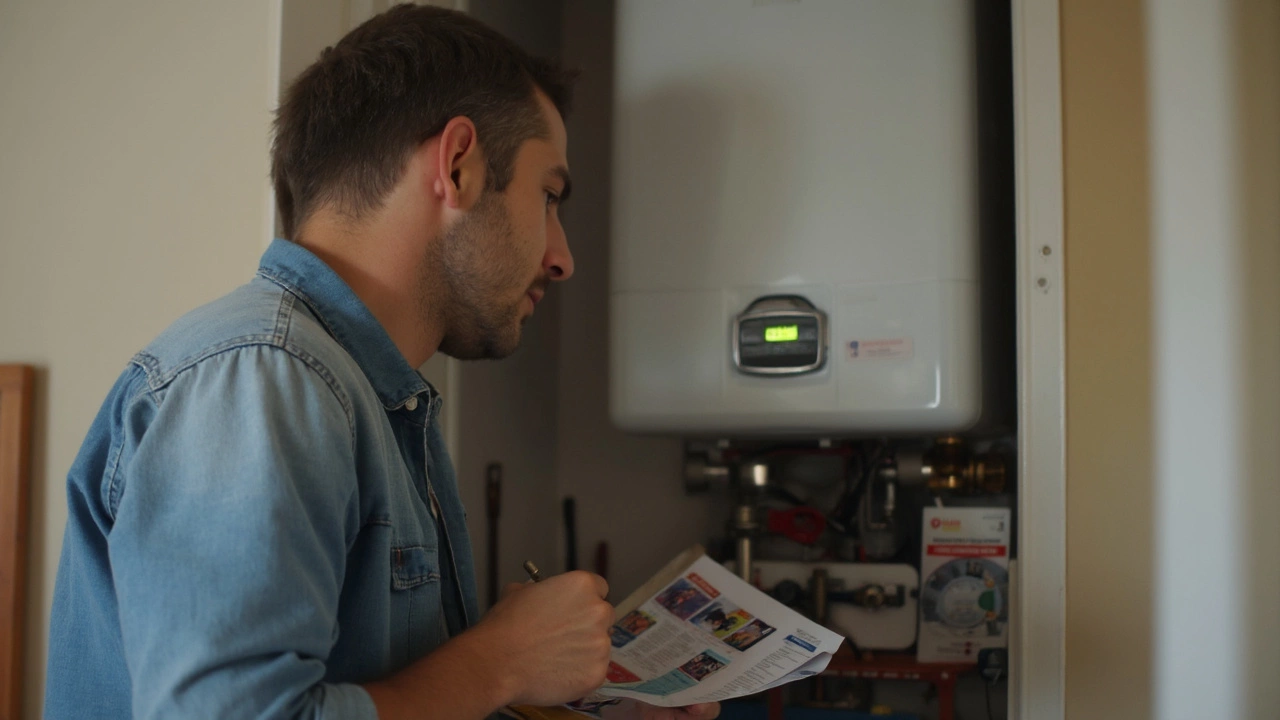If every single gas appliance in your house suddenly throws a tantrum, you’re not alone—it happens more than you’d think. One minute you’re boiling water, the next everything’s cold and suspiciously silent. Before you tear your kitchen apart or start blaming the universe, check your gas supply. Is the main valve open? Sometimes, someone fiddling around in the basement (or just a repair tech on autopilot) accidentally turns off the main valve. No gas at the source means nothing works, period.
Don’t forget the obvious—have you paid your gas bill? Utilities have a sneaky way of cutting your supply without much warning if an account's overdue. And hey, if it's really stormy outside or there’s construction down the street, a mainline interruption can leave an entire block without gas for hours. It’s worth a quick look outside or even a call to your utility company before you start troubleshooting inside your house. Cut the guesswork and check these basics first—it’s faster than hunting for tools.
- Is Your Gas Supply Actually Working?
- Pilot Lights and Ignition Problems
- Blocked or Faulty Gas Lines
- When to Call for Help
Is Your Gas Supply Actually Working?
This might sound obvious, but you’d be surprised how often people overlook the basics: is gas even getting into your home? When gas appliance repair pros show up, the first thing they check is the gas supply—because if you don’t have gas, nothing else matters.
Start by checking the main gas valve. Usually, you’ll find it close to your gas meter or where the gas line enters your house. If it’s perpendicular to the pipe, it’s off. Turn it parallel to let the gas flow. Next, look for any “shut-off” valves near individual appliances. Sometimes one gets bumped or turned by accident, especially during cleaning or moving stuff around.
Not sure if the problem is in your house or the neighborhood? Look outside for roadwork or check with neighbors. If everyone’s heater and stove quit at once, it’s probably a supply issue from the utility company.
Another sneaky culprit is a tripped gas safety shut-off device, often called an Excess Flow Valve (EFV). These kick in during major leaks or sudden pressure changes. If yours is tripped, you’ll see no gas flow anywhere until a pro resets it.
Here’s a checklist you can run through fast before diving into complicated troubleshooting:
- Main valve is open (handle is parallel to pipe)
- All appliance-specific shut-offs are open
- No scheduled utility work or outages nearby
- No gas smell (leave and call 911 if there is!)
If you’re still unsure, here’s a quick comparison of reasons for lost gas supply and what you can quickly check yourself:
| Possible Cause | Do-It-Yourself Check? | Who to Call |
|---|---|---|
| Main gas valve off | Yes | You |
| Unpaid bill/shutoff | Yes | Utility company |
| Neighborhood gas outage | Ask neighbors | Utility company |
| Tripped EFV/safety shut-off | No | Licensed technician |
| Hidden appliance shut-off | Yes | You |
Run through these steps, and nine times out of ten, you’ll get to the root of the problem—before breaking out the toolbox or calling for expensive repairs.
Pilot Lights and Ignition Problems
If your gas appliances have suddenly given up, don’t skip over the basics—pilot lights and electronic igniters mess up more often than people admit. Older gas appliances like furnaces and water heaters usually rely on a pilot light, which is a tiny flame that stays on constantly. If that flame goes out, your appliance won’t budge, even if everything else is fine. Sometimes, a strong draft, a bump, or even dirt buildup can snuff it out.
Most newer appliances use spark igniters or hot-surface igniters instead of pilot lights. Electronics can fail—wires break, sensors get covered in gunk, or the ceramic tip on a hot-surface igniter just burns out over time. Try turning on your appliance and listen: do you hear that familiar click-click? No sound at all could mean your ignition system isn’t doing anything.
Here’s what you can check first at home:
- For a pilot light, follow the instructions on your appliance’s sticker to relight it. Usually, there’s a knob you hold down while pushing an ignition button or using a long lighter. If it won’t stay lit, the thermocouple (a safety sensor) is likely shot.
- For modern ignition systems, try resetting the appliance by turning it off, waiting a minute, and then firing it up again. Sometimes electronics just need a break.
- If your gas stove isn’t clicking, check for food or debris around the igniter. A good cleaning with a dry toothbrush often brings it back to life.
Never stick your hands or tools inside an appliance if you smell gas—stop and call a pro. Ignition failures are a top reason for gas appliance repair calls, so don’t feel bad if you can't fix it yourself. If you keep relighting a pilot and it keeps going out, skip the headache and ring for help. You could be dealing with a worn part or a bigger safety issue.

Blocked or Faulty Gas Lines
Think of your home’s gas lines like your veins—if one gets blocked or leaks, nothing works right. Gas appliances depend on a steady, uninterrupted flow. Sometimes, the problem isn’t in the appliance at all but in the pipes leading up to it. If none of your appliances are firing up, this is a prime suspect.
Gas lines can get blocked by debris, rust, or even spider webs in older homes. Yes, spiders love to crawl into tiny pilot tubes, making them the unlikely villains in more no-heat calls than you’d guess. Corrosion is another big culprit—steel gas pipes, especially those over 30 years old, pretty much invite rust. If you smell that classic “rotten egg” odor, that’s a warning sign of a leak because utility companies add that scent to keep you safe.
Don’t start yanking on pipes—gas is nothing to mess with. Still, here’s how you can check for signs that something’s off:
- Listen for hissing around joints and valves—this means a leak.
- Check for dirt or dust blowing from around pipes underground; escaping gas can push soil around.
- Watch your appliances struggle—weak flames on your stove or only half your burners working are classic low-pressure signs.
According to a 2024 industry survey, pipe leaks and blockages account for over 27% of gas appliance repair visits in the US. Here’s a breakdown from actual repair reports:
| Issue | % of Cases |
|---|---|
| Rust/Corrosion Blockages | 15% |
| Spider Webs/Pest Blockages | 5% |
| Physical Pipe Damage | 7% |
If you notice any of these signs, especially a rotten egg smell, leave the house and call your gas company right away from outside. Waiting can seriously risk your safety. Most minor blockages need a tech with the right tools anyway—they can inspect and clear out lines without causing extra damage. Don’t risk it with DIY here.
When to Call for Help
Trying to fix gas appliances sounds easy until you hit a wall—or make things worse. Gas isn’t something to mess with if you’re not sure what you’re doing. That’s why there’s a clear line between simple checks and must-call-the-pro moments. If you ever smell rotten eggs (yep, that’s additives in natural gas), your eyes or nose burn, or you feel dizzy and lightheaded, get everyone outside and call the gas company or 911. No second guesses—these are signs of a leak and a real danger.
Even if there’s no funny smell, stubborn problems are a flag it's time to call a licensed tech. Say your appliances all quit working together and flipping the main valve or relighting pilot lights didn’t work. Or maybe you see visible damage—cracked pipes, hissing valves, burnt marks, or anything looking sketchy behind an appliance. If you need to open sealed parts or touch wiring or controls under big warning stickers, that’s a no-go for DIY.
- Your gas appliance repair skills probably don’t cover pressure testing or fixing a faulty regulator. These repairs require special tools and training that homeowners don’t have.
- Gas line repairs (even small ones!) are usually illegal for anyone but licensed plumbers or technicians. Getting this wrong can void insurance or lead to massive fines if something goes wrong later. It’s not worth saving a few bucks up front.
Here’s a breakdown of when you can handle it versus when to call the pros:
| Situation | DIY Possible? | Call for Help? |
|---|---|---|
| Relighting accessible pilot light (with no strong gas smell) | Yes | No |
| Changing batteries in ignition system | Yes | No |
| Suspected gas leak or strong odor | No | Yes |
| Repairing/replacing gas lines or regulators | No | Yes |
| Loss of gas across all appliances with no notice | No | Yes |
Licensed experts are trained for a reason—they handle carbon monoxide risks, pressure testing, and system checks that keep everyone safe. Remember, DIY mistakes with gas can cause explosions or deadly leaks, and insurance won’t bail you out if you didn’t have the right qualifications. When in doubt, pick up the phone and call a pro. Peace of mind is cheaper than dealing with a disaster.
